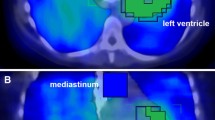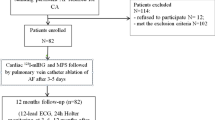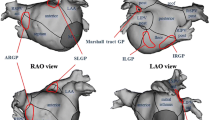Abstract
Background
Ablating left atrial (LA) ganglionated plexi (GP), identified invasively by high-frequency stimulation (HFS) during pulmonary vein isolation (PVI), may reduce atrial fibrillation (AF) recurrence. 123I-metaiodobenzylguanidine (123I-mIBG) solid-state SPECT LA innervation imaging (LAII) has the spatial resolution to detect LAGP non-invasively but this has never been demonstrated in clinical practice.
Methods
20 prospective patients with paroxysmal AF scheduled for PVI underwent 123I-mIBG LAII. High-resolution tomograms, reconstructed where possible using cardiorespiratory gating, were co-registered with pre-PVI cardiac CT. Location and reader confidence (1 [low] to 3 [high]) in discrete 123I-mIBG LA uptake areas (DUAs) were recorded and correlated with HFS.
Results
A total of 73 DUAs were identified, of which 59 (81%) were HFS positive (HFS +). HFS + likelihood increased with reader confidence (92% [score 3]). 64% of HFS-negative DUAs occurred over the lateral and inferior LA. Cardiorespiratory gating reduced the number of DUAs per patient (4 vs 7, P = .001) but improved: HFS + predictive value (76% vs 49%); reader confidence (2 vs 1, P = .02); and inter-observer, intra-observer, and inter-study agreement (κ = 0.84 vs 0.68; 0.82 vs 0.74; 0.64 vs 0.53 respectively).
Conclusions
123I-mIBG SPECT/CT LAII accurately and reproducibly identifies GPs verified by HFS, particularly when reconstructed with cardiorespiratory gating.







Similar content being viewed by others
Abbreviations
- AF:
-
Atrial fibrillation
- CZT:
-
Cadmium-zinc-telluride
- DMR:
-
DUA-to-mediastinal ratio
- DUA:
-
Discrete uptake area
- GP:
-
Ganglionated plexus
- HFS:
-
High-frequency stimulation
- 123I-mIBG:
-
Iodine-123 metaiodobenzylguanidine
- SPECT:
-
Single-photon emission computed tomography
- LAII:
-
Left atrial innervation imaging
- PVI:
-
Pulmonary vein isolation
References
Haïssaguerre M, Jaïs P, Shah DC, Takahashi A, Hocini M, Quiniou G, et al. Spontaneous initiation of atrial fibrillation by ectopic beats originating in the pulmonary veins. N Engl J Med 1998;339:659-66.
Haïssaguerre M, Shah DC, Jaïs P, Hocini M, Yamane T, Deisenhofer I, et al. Electrophysiological breakthroughs from the left atrium to the pulmonary veins. Circulation 2000;102:2463-5.
Wazni OM, Marrouche NF, Martin DO, Verma A, Bhargava M, Saliba W, et al. Radiofrequency ablation vs antiarrhythmic drugs as first-line treatment of symptomatic atrial fibrillation: A randomized trial. JAMA 2005;293:2634-40.
Fink T, Schlüter M, Heeger C-H, Lemes C, Maurer T, Reissmann B, et al. Stand-alone pulmonary vein isolation versus pulmonary vein isolation with additional substrate modification as index ablation procedures in patients with persistent and long-standing persistent atrial fibrillation: The randomized alster-lost-af trial (ablation at St. Georg Hospital for long-standing persistent atrial fibrillation). Circ Arrhythm Electrophysiol 2017;10:e005114.
Lu Z, Scherlag BJ, Lin J, Yu L, Guo J-H, Niu G, et al. Autonomic mechanism for initiation of rapid firing from atria and pulmonary veins: Evidence by ablation of ganglionated plexi. Cardiovasc Res 2009;84:245-52.
Pauza DH, Skripka V, Pauziene N, Stropus R. Morphology, distribution, and variability of the epicardiac neural ganglionated subplexuses in the human heart. Anat Rec 2000;259:353-82.
Armour JA, Murphy DA, Yuan BX, Macdonald S, Hopkins DA. Gross and microscopic anatomy of the human intrinsic cardiac nervous system. Anat Rec 1997;247:289-98.
Po SS, Nakagawa H, Jackman WM. Localization of left atrial ganglionated plexi in patients with atrial fibrillation. J Cardiovasc Electrophysiol 2009;20:1186-9.
Katritsis DG, Giazitzoglou E, Zografos T, Pokushalov E, Po SS, Camm AJ. Rapid pulmonary vein isolation combined with autonomic ganglia modification: A randomized study. Heart Rhythm 2011;8:672-8.
Katritsis DG, Pokushalov E, Romanov A, Giazitzoglou E, Siontis GCM, Po SS, et al. Autonomic denervation added to pulmonary vein isolation for paroxysmal atrial fibrillation: A randomized clinical trial. J Am Coll Cardiol 2013;62:2318-25.
Pokushalov E, Romanov A, Artyomenko S, Turov A, Shirokova N, Katritsis DG. Left atrial ablation at the anatomic areas of ganglionated plexi for paroxysmal atrial fibrillation. Pacing Clin Electrophysiol PACE 2010;33:1231-8.
Kurotobi T, Shimada Y, Kino N, Ito K, Tonomura D, Yano K, et al. Features of intrinsic ganglionated plexi in both atria after extensive pulmonary isolation and their clinical significance after catheter ablation in patients with atrial fibrillation. Heart Rhythm 2015;12:470-6.
Malcolme-Lawes LC, Lim PB, Wright I, Kojodjojo P, Koa-Wing M, Jamil-Copley S, et al. Characterization of the left atrial neural network and its impact on autonomic modification procedures clinical perspective. Circ Arrhythm Electrophysiol 2013;6:632-40.
Jacobson AF, Deng H, Lombard J, Lessig HJ, Black RR. 123I-meta-iodobenzylguanidine scintigraphy for the detection of neuroblastoma and pheochromocytoma: Results of a meta-analysis. J Clin Endocrinol Metab 2010;95:2596-606.
Jacobson AF, Senior R, Cerqueira MD, Wong ND, Thomas GS, Lopez VA, et al. Myocardial iodine-123 meta-iodobenzylguanidine imaging and cardiac events in heart failure: Results of the prospective ADMIRE-HF (AdreView myocardial imaging for risk evaluation in heart failure) study. J Am Coll Cardiol 2010;55:2212-21.
Chirumamilla A, Travin MI. Cardiac applications of 123I-mIBG imaging. Semin Nucl Med 2011;41:374-87.
Raffel DM, Wieland DM. Development of mIBG as a cardiac innervation imaging agent. JACC Cardiovasc Imaging 2010;3:111-6.
Wollenweber T, Bengel FM. Molecular imaging to predict ventricular arrhythmia in heart failure. J Nucl Cardiol 2014;21:1096-109.
Flotats A, Carrió I, Agostini D, Le Guludec D, Marcassa C, Schäfers M, et al. Proposal for standardization of 123I-metaiodobenzylguanidine (MIBG) cardiac sympathetic imaging by the EANM Cardiovascular Committee and the European Council of Nuclear Cardiology. Eur J Nucl Med Mol Imaging 2010;37:1802-12.
Bellevre D, Manrique A, Legallois D, Bross S, Baavour R, Roth N, et al. First determination of the heart-to-mediastinum ratio using cardiac dual isotope (123I-MIBG/99mTc-tetrofosmin) CZT imaging in patients with heart failure: The ADRECARD study. Eur J Nucl Med Mol Imaging 2015;42:1912-9.
Gambhir SS, Berman DS, Ziffer J, Nagler M, Sandler M, Patton J, et al. A novel high-sensitivity rapid-acquisition single-photon cardiac imaging camera. J Nucl Med 2009;50:635-43.
Kirchhof P, Benussi S, Kotecha D, Ahlsson A, Atar D, Casadei B, et al. 2016 ESC guidelines for the management of atrial fibrillation developed in collaboration with EACTS. Eur Heart J 2016;37:2893-962.
Bombardieri E, Giammarile F, Aktolun C, Baum RP, Bischof Delaloye A, Maffioli L, et al. 131I/123I-metaiodobenzylguanidine (mIBG) scintigraphy: Procedure guidelines for tumour imaging. Eur J Nucl Med Mol Imaging 2010;37:2436-46.
Administration of Radioactive Substances Advisory Committee. Notes for guidance on the clinical administration of radiopharmaceuticals and use of sealed radioactive sources. Chilton: NRPB; 2017. https://www.gov.uk/government/uploads/system/uploads/attachment_data/file/590649/ARSAC_NfG_2017.pdf. Accessed 28 Dec 2017.
Imbert L, Poussier S, Franken PR, Songy B, Verger A, Morel O, et al. Compared performance of high-sensitivity cameras dedicated to myocardial perfusion SPECT: A comprehensive analysis of phantom and human images. J Nucl Med 2012;53:1897-903.
Nakazato R, Berman DS, Hayes SW, Fish M, Padgett R, Xu Y, et al. Myocardial perfusion imaging with a solid-state camera: Simulation of a very low dose imaging protocol. J Nucl Med 2013;54:373-9.
Joint Committee for Guides in Metrology. Evaluation of measurement data—Guide to the expression of uncertainty in measurement (GUM). JCGM 2008. https://www.bipm.org/en/publications/guides/gum. Accessed 29 Aug 2018.
Nakagawa H, Scherlag BJ, Patterson E, Ikeda A, Lockwood D, Jackman WM. Pathophysiologic basis of autonomic ganglionated plexus ablation in patients with atrial fibrillation. Heart Rhythm 2009;6:S26-34.
Lemery R, Cleland M, Bernick J, Wells GA. Contact force mapping and voltage thresholds during high-frequency stimulation of human cardiac ganglionated plexuses. Europace 2015;17:552-8.
Landis JR, Koch GG. The measurement of observer agreement for categorical data. Biometrics 1977;33:159-74.
Akutsu Y, Kaneko K, Kodama Y, Li H-L, Suyama J, Shinozuka A, et al. Iodine-123 mIBG imaging for predicting the development of atrial fibrillation. JACC Cardiovasc Imaging 2011;4:78-86.
Akutsu Y, Kaneko K, Kodama Y, Li H-L, Asano T, Suyama J, et al. Usefulness of severe cardiac sympathetic dysfunction to predict the occurrence of rapid atrial fibrillation in patients with Wolff-Parkinson-White syndrome. Am J Cardiol 2013;112:688-93.
Verschure DO, Veltman CE, Manrique A, Somsen GA, Koutelou M, Katsikis A, et al. For what endpoint does myocardial 123I-MIBG scintigraphy have the greatest prognostic value in patients with chronic heart failure? Results of a pooled individual patient data meta-analysis. Eur Heart J Cardiovasc Imaging 2014;15:996-1003.
Shah AM, Bourgoun M, Narula J, Jacobson AF, Solomon SD. Influence of ejection fraction on the prognostic value of sympathetic innervation imaging with iodine-123 MIBG in heart failure. JACC Cardiovasc Imaging 2012;5:1139-46.
Nishisato K, Hashimoto A, Nakata T, Doi T, Yamamoto H, Nagahara D, et al. Impaired cardiac sympathetic innervation and myocardial perfusion are related to lethal arrhythmia: Quantification of cardiac tracers in patients with ICDs. J Nucl Med 2010;51:1241-9.
Marshall A, Cheetham A, George RS, Mason M, Kelion AD. Cardiac iodine-123 metaiodobenzylguanidine imaging predicts ventricular arrhythmia in heart failure patients receiving an implantable cardioverter-defibrillator for primary prevention. Heart 2012;98:1359-65.
Boogers MJ, Borleffs CJW, Henneman MM, van Bommel RJ, van Ramshorst J, Boersma E, et al. Cardiac sympathetic denervation assessed with 123-iodine metaiodobenzylguanidine imaging predicts ventricular arrhythmias in implantable cardioverter-defibrillator patients. J Am Coll Cardiol 2010;55:2769-77.
Arimoto T, Tada H, Igarashi M, Sekiguchi Y, Sato A, Koyama T, et al. High washout rate of iodine-123-metaiodobenzylguanidine imaging predicts the outcome of catheter ablation of atrial fibrillation. J Cardiovasc Electrophysiol 2011;22:1297-304.
Fallavollita JA, Heavey BM, Luisi AJ, Michalek SM, Baldwa S, Mashtare TL, et al. Regional myocardial sympathetic denervation predicts the risk of sudden cardiac arrest in ischemic cardiomyopathy. J Am Coll Cardiol 2014;63:141-9.
Fujita W, Matsunari I, Aoki H, Nekolla SG, Kajinami K. Prediction of all-cause death using 11C-hydroxyephedrine positron emission tomography in Japanese patients with left ventricular dysfunction. Ann Nucl Med 2016;30:461-7.
Kobayashi R, Chen X, Werner RA, Lapa C, Javadi MS, Higuchi T. New horizons in cardiac innervation imaging: introduction of novel 18F-labeled PET tracers. Eur J Nucl Med Mol Imaging 2017;44:2302-9.
Hauser TH, Peters DC, Wylie JV, Manning WJ. Evaluating the left atrium by magnetic resonance imaging. Europace 2008;10:iii22-7.
Biermann J, Bode C, Asbach S. Intracardiac echocardiography during catheter-based ablation of atrial fibrillation. Cardiol Res Pract 2012. https://www.ncbi.nlm.nih.gov/pmc/articles/PMC3368317/. Accessed 29 Aug 2018.
Acknowledgements
The authors wish to thank U. Voss, Department of Nuclear Medicine, Royal Brompton and Harefield NHS Foundation Trust, United Kingdom for contributing to data collection; and Samy Bross, Spectrum Dynamics Medical, Caesarea, Isarel, for contribution to the development of the phantom model.
Disclosure
JS, SE, DA, and SRU receive consultancy fees from Spectrum Dynamics Medical. JS receives speaker honoraria from Canon Medical Systems Europe (previously Toshiba Medical Systems Europe). UV was employed by a restricted research grant while NR, RB, and CB are employees of Spectrum Dynamics Medical.
Ethical Approval
All procedures performed were in accordance with the ethical standards of the local Research Ethics Committee (London—Camberwell St Giles REC, reference 14/LO/2207) and with the 1964 Helsinki declaration and its later amendments or comparable ethical standards (Clinicatrials.gov Identifier NCT02267889).
Informed Consent
Informed consent was obtained from all individual participants included in the study.
Author information
Authors and Affiliations
Corresponding author
Additional information
Publisher's Note
Springer Nature remains neutral with regard to jurisdictional claims in published maps and institutional affiliations.
The authors of this article have provided a PowerPoint file, available for download at SpringerLink, which summarises the contents of the paper and is free for re-use at meetings and presentations. Search for the article DOI on SpringerLink.com.
Funding
This study was supported by Spectrum Dynamics Medical.
Electronic supplementary material
Below is the link to the electronic supplementary material.
Rights and permissions
About this article
Cite this article
Stirrup, J., Gregg, S., Baavour, R. et al. Hybrid solid-state SPECT/CT left atrial innervation imaging for identification of left atrial ganglionated plexi: Technique and validation in patients with atrial fibrillation. J. Nucl. Cardiol. 27, 1939–1950 (2020). https://doi.org/10.1007/s12350-018-01535-5
Received:
Accepted:
Published:
Issue Date:
DOI: https://doi.org/10.1007/s12350-018-01535-5




